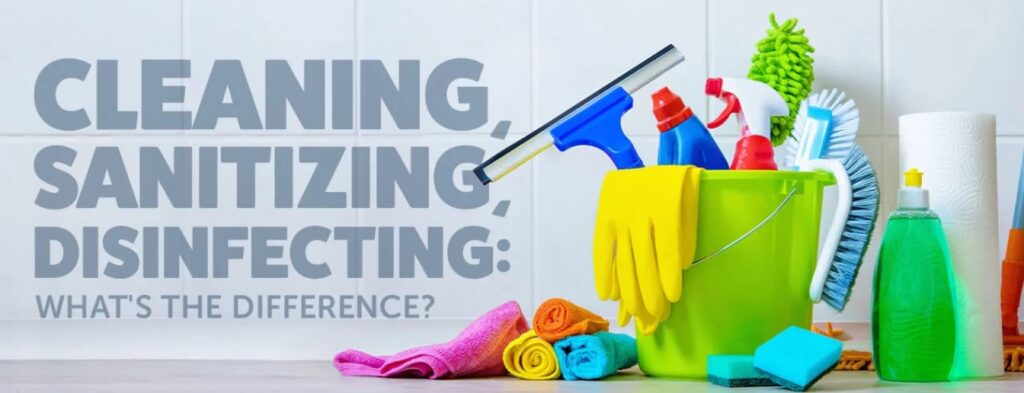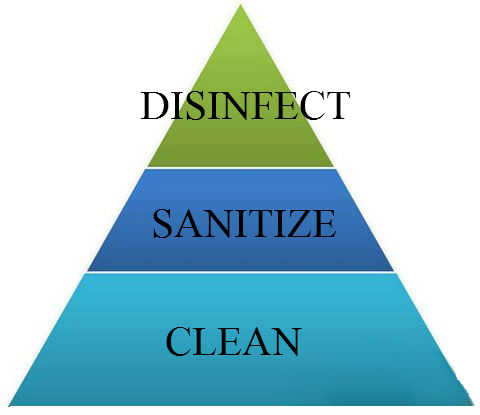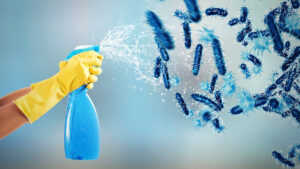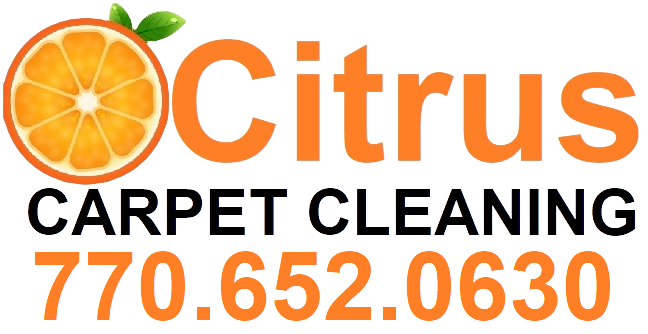What Is The Difference Between Cleaning, Sanitizing and Disinfecting?

Cleaner buildings are healthier buildings. Healthier buildings lead to healthier people and increased productivity. With the focus on health and safety, we really need to understand how cleaning, sanitizing and disinfecting help contribute favorably to this goal.
Cleaning, disinfecting, and sanitizing are part of a broad approach to preventing infectious diseases. Though these terms are often used interchangeably, it is important to note that they are actually quite different.
 Think of a triangle. Cleaning, which is used to remove dirt or debris from a surface, takes the bottom slot since it is the broadest, most basic level. Moving up on the triangle, sanitizing falls in the middle layer since this method removes microbes from a surface and kills bacteria. At the very tip of the triangle is disinfecting, the most narrowly defined of the cleaning methods. So while cleaning is sufficient in the short term for certain surfaces, it is essential to regularly carry out the full regimen of cleaning, sanitizing and disinfecting. This is especially true in healthcare facilities where medical cleaning takes precedence.
Think of a triangle. Cleaning, which is used to remove dirt or debris from a surface, takes the bottom slot since it is the broadest, most basic level. Moving up on the triangle, sanitizing falls in the middle layer since this method removes microbes from a surface and kills bacteria. At the very tip of the triangle is disinfecting, the most narrowly defined of the cleaning methods. So while cleaning is sufficient in the short term for certain surfaces, it is essential to regularly carry out the full regimen of cleaning, sanitizing and disinfecting. This is especially true in healthcare facilities where medical cleaning takes precedence.
So, what exactly is the difference between these terms?
CLEANING = REMOVE GERMS
Definition: the removal of visible soil, debris, microorganisms and organic substances from surfaces; will not eliminate germs but reduces their numbers by removing some contaminated matter.
At its elementary definition, cleaning is used to remove dirt, allergens and microorganisms from a surface and is typically completed with a cloth or wipe in conjunction with a detergent, soap or solvent. Cleaning helps reduce the number of germs that can lead to infection; however it does not necessarily kill any germs.
Cleaning is just the first step in a complete process, but it is a vital step that cannot be skipped. Even if you intend to sanitize or disinfect the area, cleaning away visible dirt dust, fingerprints and other marks beforehand makes it easier and more effective to remove microscopic germs with more intensive methods later.
SANITIZING = REDUCE GERMS
Definition: the reduction of bacteria to safe levels (set by public health standards) to decrease the risk of infection; may not kill all viruses.
A step beyond cleaning, sanitization kills a greater amount of bacteria and is required for any surface that comes into contact with food. According to the CDC definition, a sanitizer is “a chemical that kills 99.999% of the specific test bacteria in 30 seconds under the conditions of the test. Therefore, while sanitizers can kill the majority of certain kinds of bacteria, sanitization techniques and products alone cannot eliminate all viruses.
DISINFECTING = KILL GERMS
Definition: the elimination of pathogens and disease-causing microorganisms, except bacterial spores.
Disinfecting a surface means that chemicals are being used to kill germs. Disinfecting does not necessarily mean that dirt, germs, and impurities are being removed from the surface, but by killing the germs, the risk of spreading infection is lowered.
The key difference between sanitizing and disinfecting is the type of chemical involved and the length of time it is left on a surface. For many disinfectants, 10 minutes is the appropriate dwell time. However, be sure to read instructions on the chemical product to ensure proper disinfection.
To keep a hygienic and safe environment, make sure to complete the full regimen of all techniques from cleaning to sanitizing and disinfecting, as appropriate.
Are you using disinfectants the right way? Applying a product and wiping it off will kill the dangerous germs, right?
Actually, no. People often use disinfectant cleaners improperly, which can mean they’re simply spreading the germs around instead of killing them. This can actually encourage dangerous bacterial growth such as E.Coli, Salmonella, Norovirus and more. Whether you’re cleaning up after cutting raw chicken or caring for someone at home who’s been sick, effective disinfecting means doing it the right way.
But what does “the right way” mean?
Kill time / Dwell time / Contact time is key disinfectants!
 All disinfecting products need to stay wet on the surface for a certain amount of time to kill bacteria and viruses. This is called “kill time”, “dwell time” and/or “contact time” on product labels. Kill time varies depending on the product, and often even between products made by the same company.
All disinfecting products need to stay wet on the surface for a certain amount of time to kill bacteria and viruses. This is called “kill time”, “dwell time” and/or “contact time” on product labels. Kill time varies depending on the product, and often even between products made by the same company.
Remember, disinfectants only work while wet.
If a disinfectant dries quickly, you’ll have to reapply it until the kill time is reached, according to EPA regulations (and, often, the product’s label). Many of these products also contain alcohol, which can cause the liquid to dry quickly. This can make it difficult to keep the surface wet without re-wiping multiple times, so you’re better off using a spray disinfectant cleaner.
Disinfecting wipes are popular for their convenience, but their label directions usually instruct you to leave the cleaning surface visibly wet for 4-10 minutes, in order to fully eliminate dangerous illness-causing bacteria.
How often do you stand and wait to ensure your wiped surfaces stay wet? If it dries before the kill time is met, then you haven’t actually disinfected anything. Illness and disease-causing pathogens could still be there.
Don’t take chances with your family’s health.
As an alternative to wipes, a disinfectant spray cleaner may offer the better option. It can apply more liquid to the surface, and as a result is more likely to leave a surface wet for the required time than a wipe, without the need for reapplication. It also allows you to reach crack and crevice areas that wipes can’t penetrate.
